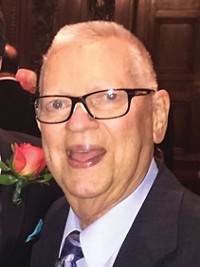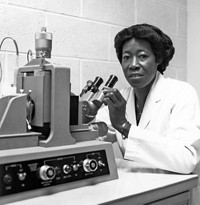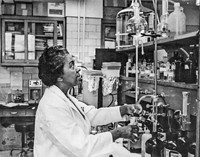Advertisement
Grab your lab coat. Let's get started
Welcome!
Welcome!
Create an account below to get 6 C&EN articles per month, receive newsletters and more - all free.
It seems this is your first time logging in online. Please enter the following information to continue.
As an ACS member you automatically get access to this site. All we need is few more details to create your reading experience.
Not you? Sign in with a different account.
Not you? Sign in with a different account.
ERROR 1
ERROR 1
ERROR 2
ERROR 2
ERROR 2
ERROR 2
ERROR 2
Password and Confirm password must match.
If you have an ACS member number, please enter it here so we can link this account to your membership. (optional)
ERROR 2
ACS values your privacy. By submitting your information, you are gaining access to C&EN and subscribing to our weekly newsletter. We use the information you provide to make your reading experience better, and we will never sell your data to third party members.
People
Percy L. Julian: 'Forever Fight To Keep Hope Alive!'
by Anne T. O'Brien, Director, District I
January 22, 2007
| A version of this story appeared in
Volume 85, Issue 4
"Forgotten Genius," a two-hour NOVA program on Percy L. Julian, will be broadcast nationwide by PBS on Feb. 6. ACS will celebrate on Jan. 23 at the National Academy of Sciences, to which Julian was the first African American chemist admitted.
His story cannot but inspire. Born in Montgomery, Ala., in 1899, the grandson of slaves and son of a mail clerk who loved philosophy and mathematics, Julian was educated when formal schooling for blacks was inadequate, but young Percy promised his grandfather to "forever fight to keep hope alive!"
Julian gained admission as a "subfreshman" to DePauw University where, for the first time, he shook the hand of a white man. He lived in an attic and earned his way by waiting on tables and digging ditches. Julian graduated with a degree in chemistry, Phi Beta Kappa, first in his class, valedictorian.
Despite his having earned a master's degree at Harvard University and because of the prevailing racial climate, Julian's further advancement in the various institutions where he taught and his quest of the Ph.D. were both discouraged. In response, Julian obtained a Rockefeller fellowship to support pursuit of his doctorate at the University of Vienna.
Armed with a Ph.D., Julian returned to the U.S. seeking a position at a major university or in industry. After some time, he returned to DePauw as a research fellow. There, together with a colleague, he synthesized physostigmine, an alkaloid previously available only by isolation from the African calabar bean. Still, he was not hired as a professor. The synthesis of this acetylcholinesterase inhibitor, used to treat glaucoma, was later recognized as an ACS National Historic Chemical Landmark.
In 1936, W. J. O'Brien, vice president of Glidden, hired Julian as director of research of the Soya Division of the Chicago paint and chemical company-a truly unprecedented position for an African American at the time. At Glidden, Julian extracted lecithin, and, from soy proteins, made a fire-retardant foam credited with saving thousands of lives in World War II. This "bean-soup" extinguished hydrocarbon fires on aircraft carriers. Julian's persistence in his conviction of the synthetic utility of "Compound S," 11-deoxycortisol, resulted in a commercially viable route to cortisone. It offered the only available relief to many arthritics at the time.
Eventually, Julian, who had synthesized progesterone and testosterone, recognized the Mexican yam as an excellent source of steroid starting materials from which sex hormones could be made and began his life as an entrepreneur. He established his own company, Julian Laboratories. He later sold his company for $2 million to Smith, Kline & French, which eventually merged into GlaxoSmithKline.
Julian's work made birth control, arthritis and glaucoma medications, and immunosuppressants less expensive and more broadly available. He held about 130 patents and received 19 honorary doctorates and numerous civic and academic honors. He contributed to many scholarly societies and boards of directors; he has been recognized in the many schools and labs named after him.
An active member of ACS, Julian published in its journals, brought students to national meetings, spoke at local sections, and wrote letters to C&EN. He was also a skier, a poet, a pianist, a tennis player-a real human being, an inclusive man. He once brought a good suit of clothes to a colleague who at the time did not have one, saying, "Here, keep these for when we go out to lunch!"
Julian's story is well told in a C&EN cover story (Feb. 1, 1993, page 9). That story was occasioned by the issuance of a postage stamp in honor of Julian, who had been a founding trustee of Roosevelt University in Chicago. In 1945, this new, free, and open-admission school for people of all races and religions was unusual indeed. More about Julian is available online at acswebcontent.acs.org/percy_julian/more_julian.html.
Percy Julian was described by historian John Hope Franklin as "the most complete human being I have ever known." Julian described his own life in poet Donald Adams' words, "Take heart, I told myself, go farther on!" Perhaps he says the same to us.
ACS has celebrated Julian in symposia, in a National Historic Chemical Landmark, in festivities in the Chicago Section, and as one of C&EN's top 75 contributors to the chemical enterprise (C&EN, Jan. 12, 1998, page 179). ACS has also been deeply involved with the making of this NOVA film (C&EN, Oct. 2, 2006, page 52).
The road map for the film evolved from NOVA producer Steve Lyons' interest in Julian, which was reinforced at the 1999 symposium chaired by James P. Shoffner, adjunct professor at Columbia College Chicago and former ACS Board member, and after many conversations with Bernhard Witkop, retired chief of the laboratory of chemistry at the National Institute of Arthritis & Metabolic Disease; Shoffner; Donald Cook, professor emeritus of chemistry at DePauw; Robert L. Lichter, retired executive director of the Camille & Henry Dreyfus Foundation; the Julian family; and Julian's colleagues.
Thanks to NOVA/WGBH; to initial support by the Dreyfus Foundation and ACS; to major funding from the Alfred P. Sloan Foundation, the National Science Foundation, the National Endowment for the Humanities, and NOVA; to family and colleagues of Julian; to DePauw; to the Chemical Heritage Foundation; and to many individuals, the film has been completed.
Do watch. Do encourage friends, teachers, and students to view the Tuesday, Feb. 6, broadcast celebrating a great scientist who kept hope alive, who went farther on!
I welcome your comments at obrienatm@verizon.net.
Addendum: In addition to Julian's work in developing new process chemistry that substantially improved the yield of steroids from the Mexican yam, ACS acknowledges the important role Russell Marker played in the recognition of this plant as an excellent source of a plant sterol and in the development of chemical industries based upon human steroidal hormones.
Views expressed on this page are those of the author and not necessarily those of ACS.





Join the conversation
Contact the reporter
Submit a Letter to the Editor for publication
Engage with us on Twitter